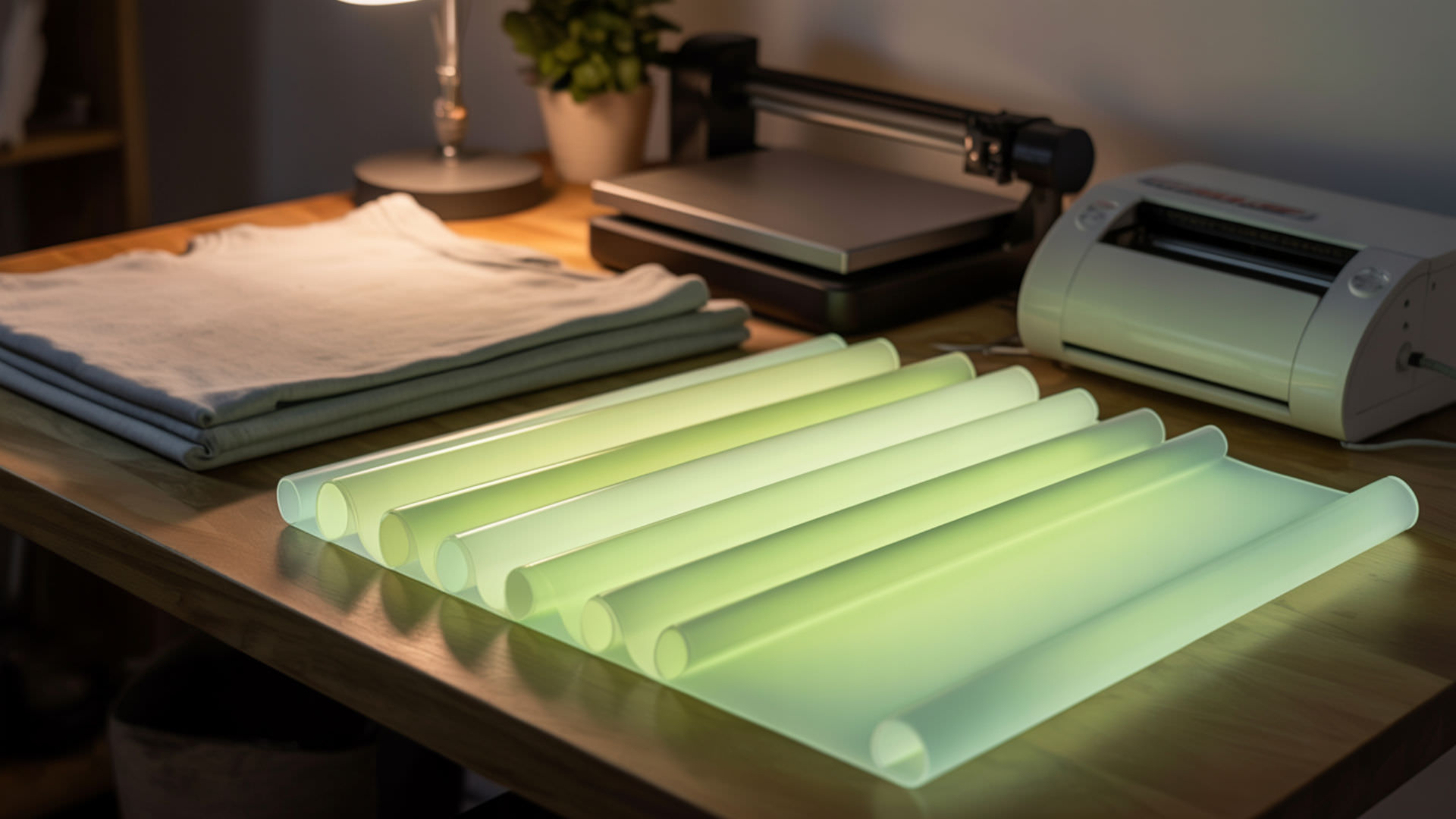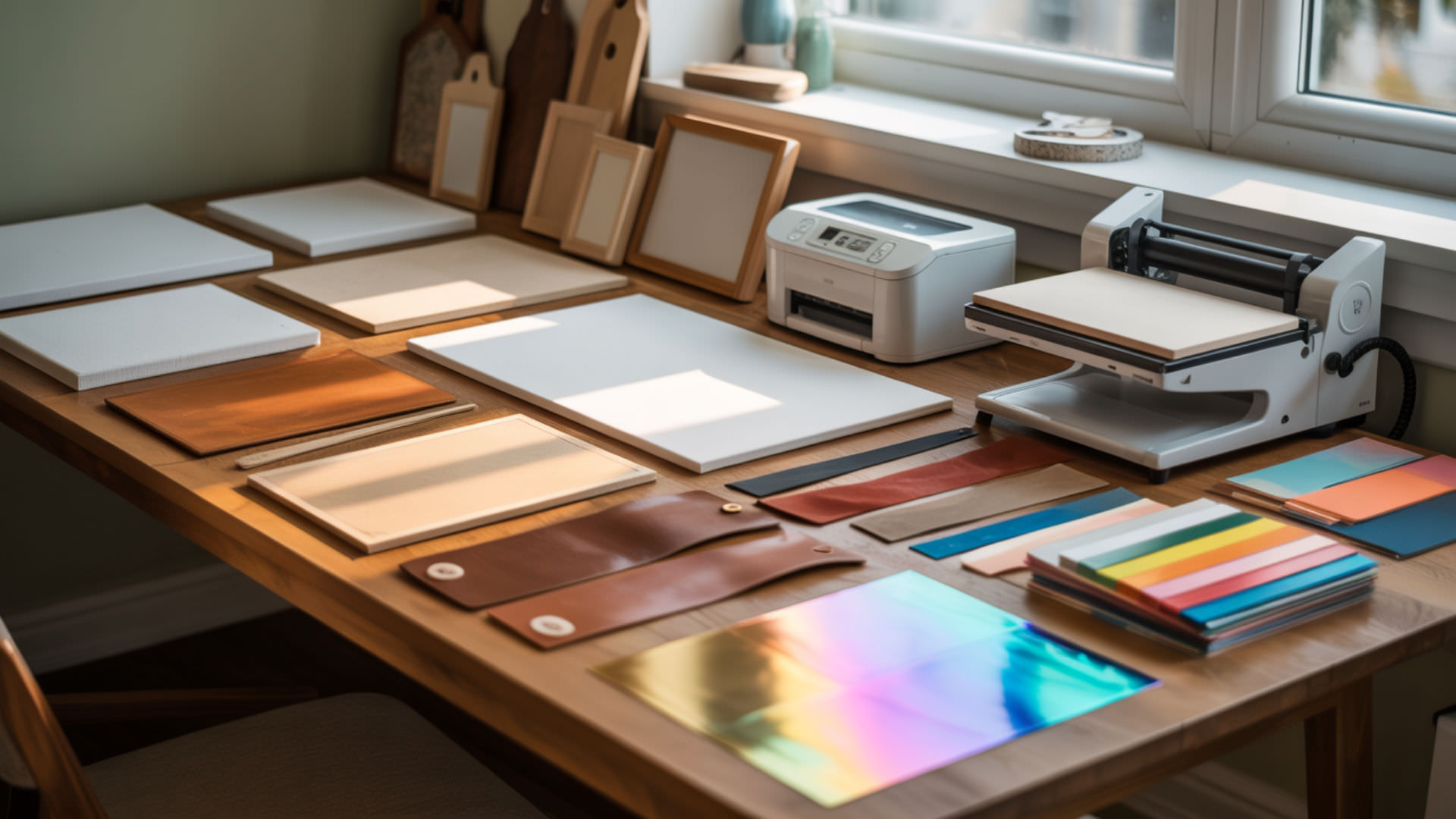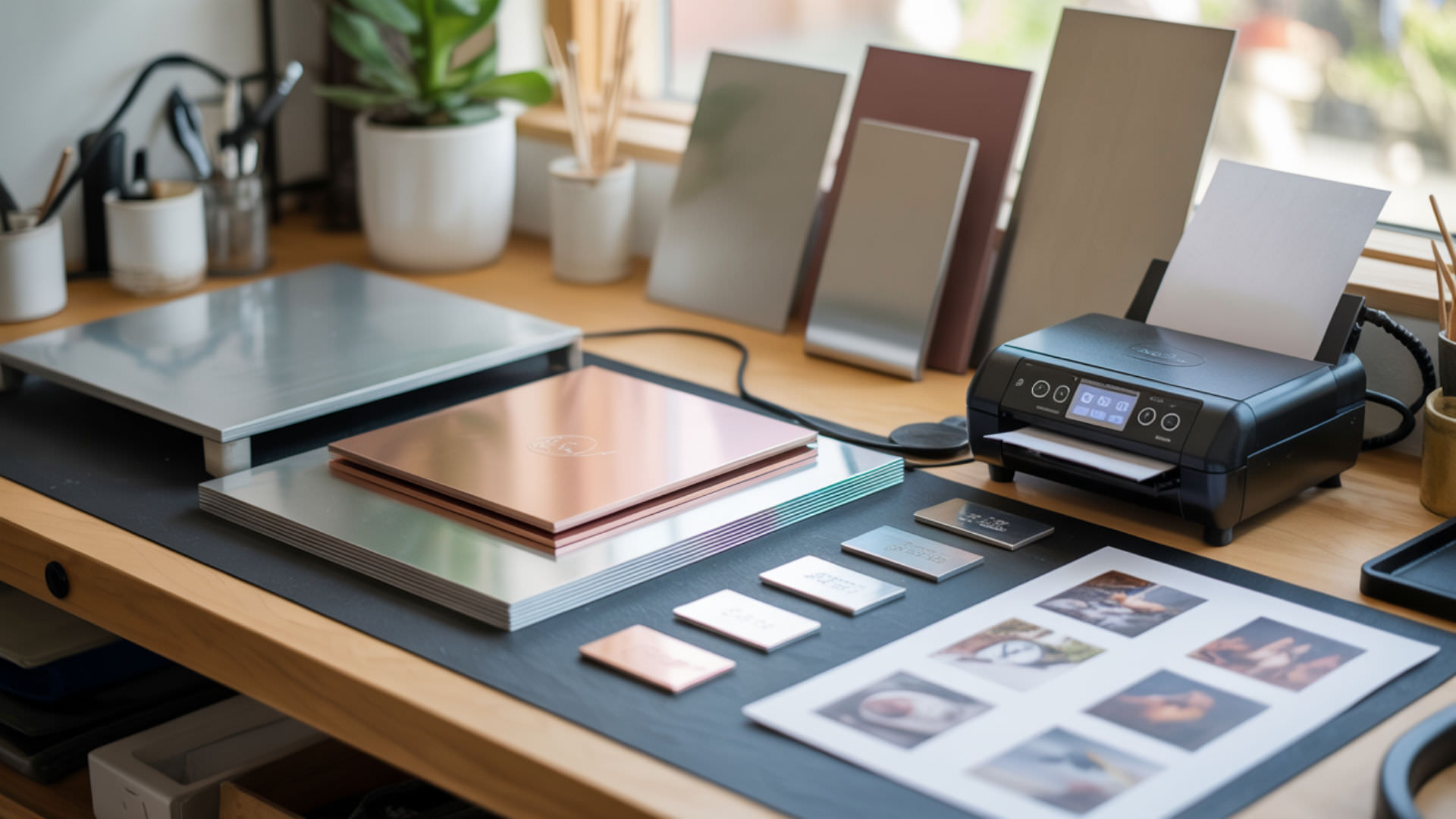Table of Contents
ToggleGlow-in-the-dark HTV combines sublimation printing with luminescent effects, creating designs that display vibrant colors in daylight and emit an ethereal glow when lights go out. The polyurethane (PU) composition of this heat transfer vinyl makes it compatible with sublimation dye, as explained in our comprehensive guide on which surfaces can you sublimate on. The PU film accepts sublimation dye while glow pigments embedded within create the luminescent effect. Understanding how PU film behaves under heat is essential for successful results, detailed in our best sublimation coating for different surface types guide.
Key Takeaways
- Phosphorescence creates the long-lasting glow mechanism in HTV—the material absorbs light energy, stores it in phosphor particles, and releases it gradually as visible light when surroundings become dark. Phosphorescence is what makes glow-in-the-dark HTV keep glowing after the light source is removed, because the material stores absorbed energy and releases it slowly as visible light. [1]
- Thermoplastic polyurethane (TPU) softens under heat, requiring careful temperature control—apply HTV at 305°F for 10–15 seconds, then sublimate at 350–380°F for 40–70 seconds.
- Light or semi-transparent sublimation designs preserve the glow effect underneath, while dark colors block the phosphorescent particles and reduce luminescence.
Can You Actually Sublimate on Glow-in-the-Dark HTV?

Yes, you can sublimate on glow-in-the-dark HTV, producing vibrant designs that also glow when charged with light. The PU film provides a sublimation-ready polymer surface that accepts dye transfer. Phosphors embedded in the vinyl create the luminescent glow effect. Temperature sensitivity means glow HTV can warp if overheated, so you must first press the HTV onto your garment at lower temperatures, then apply sublimation at carefully controlled settings to avoid damaging the material.
What Temperature Do You Sublimate Glow-in-the-Dark HTV At?
Set your heat press to around 305°F for 15 seconds to apply the HTV first, then about 375–380°F for 60–70 seconds for the sublimation layer. TPU has a lower melting point than standard sublimation substrates, requiring careful temperature control throughout the process. Some crafters successfully use 350°F for 40 seconds or even 305°F for 40 seconds, but higher temperatures risk the HTV peeling off with the sublimation paper. Always test on scrap material first. TPU behaves like a thermoplastic, meaning it softens with heat and re-hardens as it cools, which is why precise temperature control matters during both the HTV press and the sublimation step. [2]
How Long Do You Press Glow-in-the-Dark HTV for Sublimation?
Heat pressing times range from 40 to 70 seconds using medium pressure for the sublimation step. Excessive press time creates risk of thermal distortion due to the material’s temperature sensitivity. Allow the item to cool completely before peeling the sublimation paper to prevent warping and ensure even color transfer. The two-step process—first applying HTV, then sublimating—requires attention to both timing phases for professional results.
How Do You Activate and Charge Glow-in-the-Dark HTV?
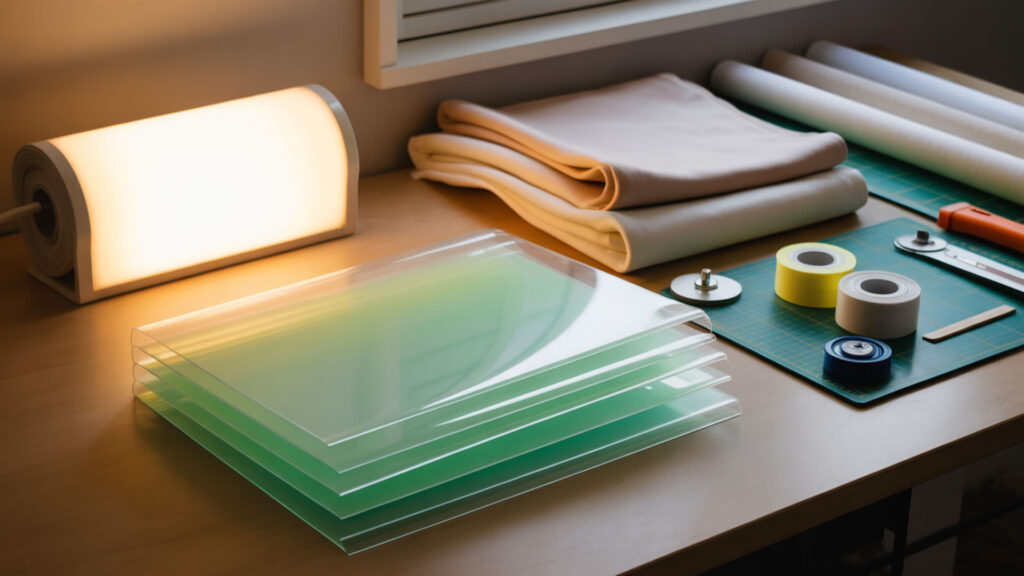
Glow-in-the-dark HTV works through photoluminescence—a light absorption mechanism where phosphor particles capture light energy. Phosphorescence then stores and releases this glow energy over time. To charge the material, expose it to sunlight or artificial light. The more light you give it, the brighter and longer it glows in the dark. Unlike chemical glow sticks that fade permanently, photoluminescent HTV can be recharged thousands of times.
How to Activate Glow-in-the-Dark HTV?
Activate glow-in-the-dark HTV by exposing it to any light source—the phosphors absorb energy and produce the characteristic glow when surroundings become dark. Afterglow duration depends on the pigment type and charge time. A few minutes of exposure to direct light is sufficient to activate the glow. If your item has been in a dark closet for a long time, it requires being in light longer to glow brighter—let it charge for at least 3 minutes in the sun.
How Long Do You Need to Charge Glow-in-the-Dark?
Charge times vary by light source: 3–4 minutes of UV (black) light, 7–8 minutes of direct sunlight, 21–23 minutes of fluorescent lighting, or 24–26 minutes of incandescent light. Strontium aluminate pigments provide longer-lasting glow than zinc sulfide formulations. High-quality strontium aluminate can glow for hours after charging and maintain glow capability for over 20 years. UV flashlights provide the fastest, most effective charging method.
What Are the Proper Settings for Glow-in-the-Dark HTV?
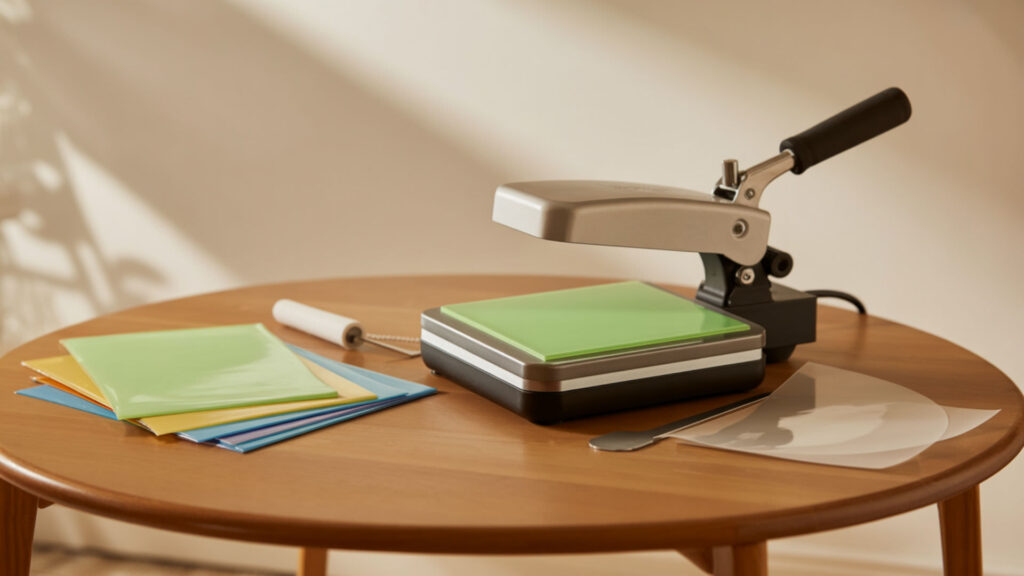
Proper settings for glow-in-the-dark HTV depend on the TPU composition and your specific product brand. The TPU material determines maximum safe temperature and pressing time. Temperature sensitivity requires starting at lower settings and testing before production runs. General guidelines suggest 300–315°F for 10–15 seconds when applying HTV to fabric, using medium to firm pressure with a cover sheet (Teflon or parchment paper) over your design.
How Long to Heat Press Glow-in-the-Dark Vinyl?
Heat pressing glow-in-the-dark vinyl typically requires 10–15 seconds at 302–315°F with high pressure for the initial HTV application. This activates the adhesive and bonds the vinyl to fabric. For the sublimation step, increase to 350–380°F for 40–70 seconds. The two-stage process—first HTV application, then sublimation transfer—requires different settings for each phase. Some manufacturers recommend using a professional craft iron on the cotton or high setting if no heat press is available.
What Is the Heat Setting for Glow-in-the-Dark Vinyl?
Heat settings for glow-in-the-dark iron-on vinyl range from 275°F to 315°F depending on your fabric and specific product. The melting point of the TPU material determines the upper limit—exceeding this causes permanent damage. Thermal expansion during heating can cause slight shifting and potential ghosting if the sublimation paper moves. Use heat-resistant tape to secure all layers and apply medium to firm pressure for 10–15 seconds with proper cover sheets.
Why Is My Glow-in-the-Dark HTV Not Glowing Properly?
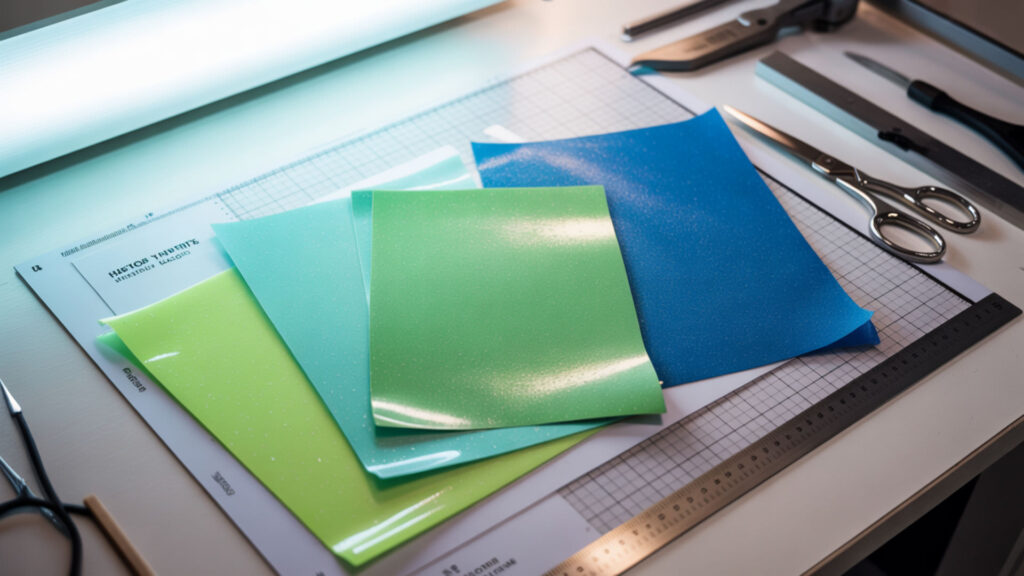
Glow-in-the-dark HTV requires adequate light exposure to charge the phosphors before it can emit a glow. Poor pigment dispersion in lower-quality vinyl causes uneven glow across the design. If your vinyl isn’t glowing, the most common cause is insufficient charge time—a few minutes of direct light exposure is typically needed. Items stored in dark closets require longer charging periods. Overheating during application can also damage phosphor particles and reduce glow intensity.
How to Fix Dull Sublimation Results on Glow-in-the-Dark HTV?
If sublimation colors appear dull, pre-press to remove moisture from the fabric and HTV before applying your design. Sublimation dyes must not completely block the phosphors—use lighter colors or semi-transparent designs to maintain glow visibility. Check your heat press temperature for accuracy and use sublimation paper designed for hard surfaces. Too little pressure or uneven heat across the PU film also reduces vibrancy. Ensure complete contact between sublimation paper and HTV surface.
Does Glow-in-the-Dark Vinyl Still Glow After Sublimation?
Yes, glow-in-the-dark vinyl still glows after sublimation if the sublimation colors aren’t too dark. Light or semi-transparent designs preserve the phosphorescence effect underneath, allowing the glow to shine through white and light gray areas of your design. Dark areas of the design will show up but block the glow in those regions. The key is balancing color vibrancy with glow visibility—avoid completely covering the vinyl with heavy, dark ink coverage.
Can You Layer on Top of Glow-in-the-Dark HTV?
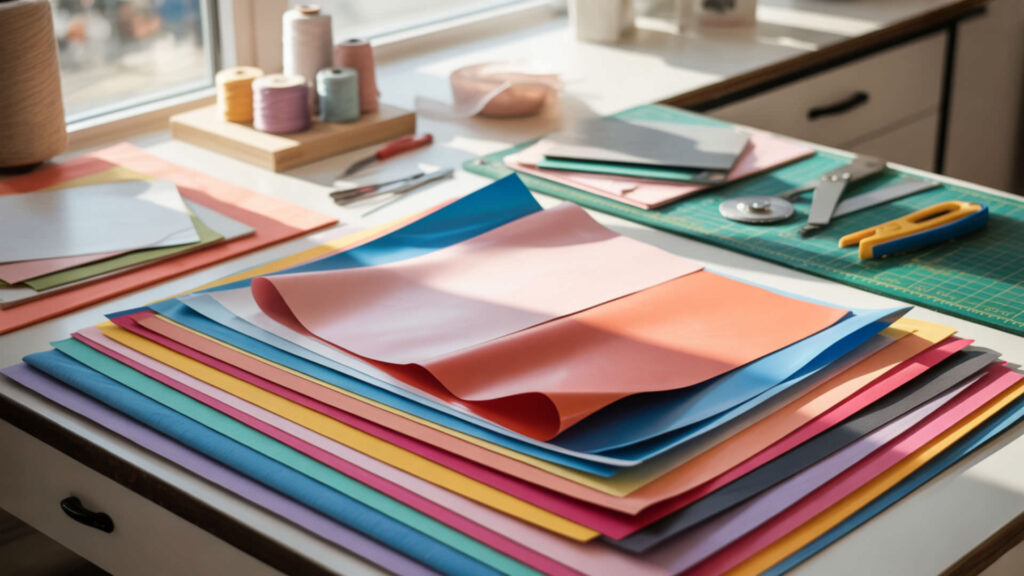
Yes, you can layer glow-in-the-dark HTV, but it’s best to layer other materials on top of it and take precautions. The adhesive layer must remain functional for successful layering—press layers one at a time with a quick tack (2–5 seconds) for initial layers, then use full recommended time for the final press. Both vinyl and glow HTV rely on PU film surface layers for layering and heat processes, as covered in our sublimation on vinyl guide. Use thin vinyl like Siser EasyWeed Stretch to avoid making designs too thick.
What Setting to Cut Glow-in-the-Dark Vinyl?
Glow-in-the-dark vinyl requires stronger cutting force than standard HTV due to its increased layer thickness. The thicker films containing glow pigments need deeper blade penetration and sometimes multiple passes. Check your cutting machine settings and adjust for specialty HTV—most machines have specific settings for thick or specialty vinyl. Test cut a small design first to verify settings before committing to larger projects, as incorrect settings cause tearing or incomplete cuts.
Is Glow-in-the-Dark Vinyl Thicker Than Regular Vinyl?
Yes, glow-in-the-dark vinyl is thicker than regular removable vinyl because glow pigments increase the overall film layer thickness. This requires adjusting your cutting settings to ensure clean cuts through the material. The thickness also affects layering—be careful not to stack too many layers, as the design becomes bulky. When layering multiple colors of glow-in-the-dark HTV together, the combined thickness can affect garment drape and comfort.
How Long Does Glow-in-the-Dark Vinyl Last After Sublimation?
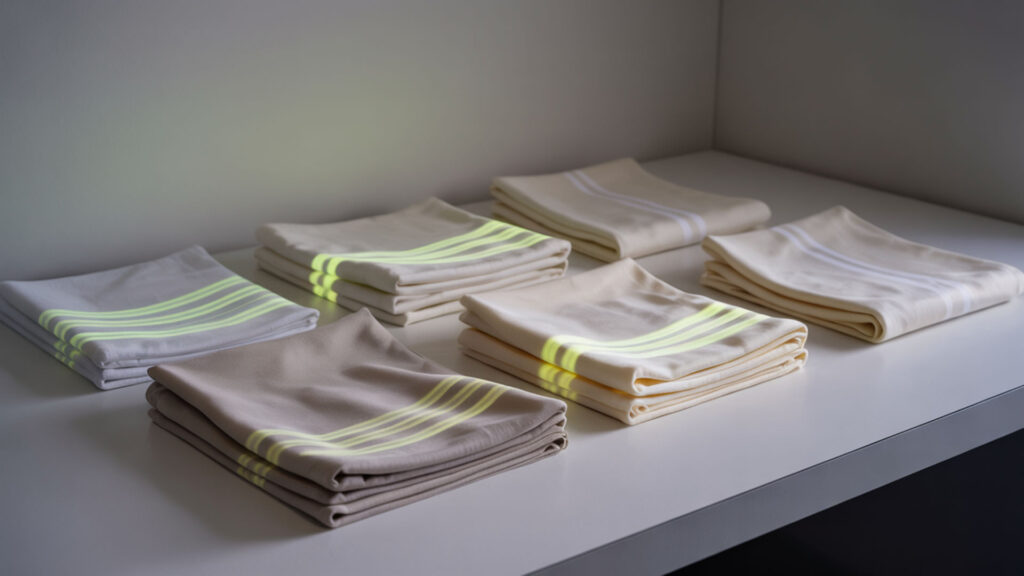
Glow-in-the-dark vinyl can last anywhere from 2 to over 10 years depending on quality, type, and application. The afterglow capability depends on phosphor quality—higher-quality phosphors determine overall longevity. Outdoor-rated vinyls typically last 4–7 years, while indoor applications can exceed 20 years. The phosphorescent material itself can retain glow capability for 20+ years before intensity begins diminishing. Proper care extends lifespan significantly.
Can You Recharge Glow-in-the-Dark?
Yes, you can recharge glow-in-the-dark items indefinitely through photoluminescence—light energy recharges glow pigments whenever exposed to any light source. UV light provides the fastest charging (seconds to minutes), while sunlight takes 30 minutes to an hour. Regular indoor lights also work but require longer exposure. The charging cycle is effectively unlimited for phosphorescent materials, though the glow intensity may gradually decrease over many years of use.
Is There a Permanent Glow-in-the-Dark?
Strontium aluminate provides the longest-lasting commercially available glow—high-quality formulations can maintain their glow capability for over 20 years under normal conditions. While no phosphorescent material glows permanently without recharging, strontium aluminate comes closest to ‘permanent’ in practical terms. Permanent glow strips are available for safety applications like corridor marking and exit highlighting. These products charge from natural or artificial light and continue functioning for decades.
How Do You Sublimate on Glow-in-the-Dark HTV Step-by-Step?
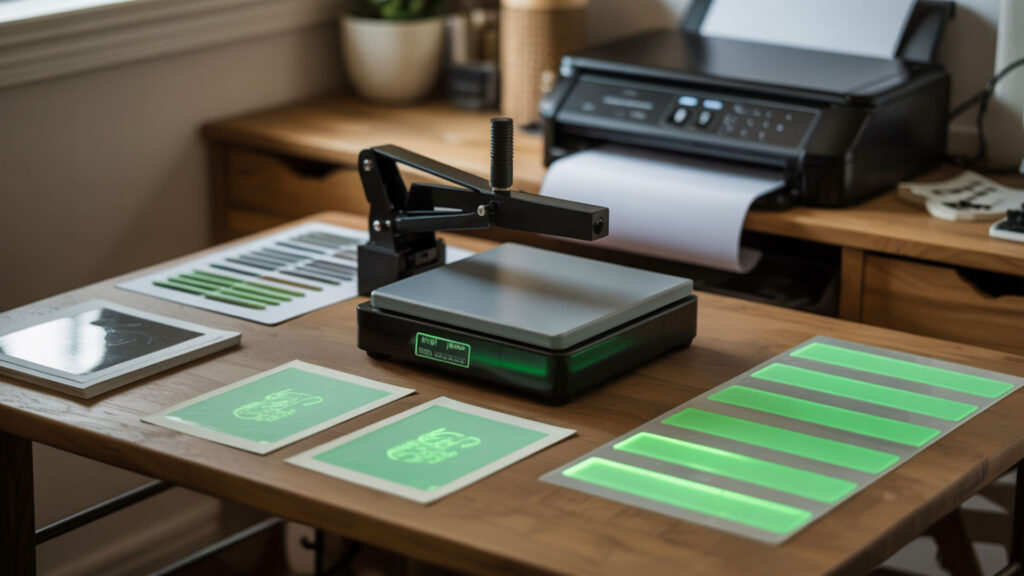
Successful glow-in-the-dark HTV sublimation requires a two-stage process: first applying the HTV to fabric, then sublimating your design onto the vinyl. The PU film must be stable and flat for successful dye transfer in the second stage. Follow these steps for professional-quality glowing sublimation projects.
- Cut your glow-in-the-dark HTV design using your cutting machine. Adjust settings for thicker specialty vinyl. Cut the vinyl without mirroring—only mirror the sublimation print. Weed away excess vinyl, leaving only your design on the carrier sheet.
- Press the glow-in-the-dark HTV onto your garment at 305°F for 10–15 seconds. Use medium to firm pressure with a cover sheet. Let it cool completely before peeling the carrier sheet. Ensure the adhesive layer has bonded firmly to the fabric before proceeding.
- Print your sublimation design, mirroring the image before printing. Cut the sublimation paper to size, ensuring it aligns correctly with the HTV design. Use high-quality sublimation ink and paper for best color vibrancy. Lighter colors preserve more glow effect.
- Position the sublimation print face down onto the HTV and secure with heat-resistant tape. Align carefully to match the vinyl shape. Place protective butcher paper on top of the design and underneath the sublimation print to protect your heat press platens.
- Heat press at 350–380°F for 40–70 seconds with medium pressure. Start with lower temperature settings (350°F for 40 seconds) and adjust based on results. Some brands work better at 305°F for 40 seconds. Test on scrap material to find optimal settings for your specific HTV brand.
- Allow to cool, then carefully peel the sublimation paper. Cooling prevents warping and ensures even color transfer. Charge the finished design by exposing it to light—the glow effect activates once the phosphors absorb sufficient light energy. Hand wash inside out in cold water to preserve both sublimation and glow.
Ready to Create Glowing Sublimation Projects?
Glow-in-the-dark sublimation opens creative possibilities for costumes, kids’ clothing, party accessories, and safety applications. The combination of PU film accepting sublimation dye and phosphors creating luminescent effects produces truly unique products. Master the two-stage pressing process—HTV application first, then sublimation—and experiment with light-colored designs that preserve maximum glow visibility. With proper technique, your creations display vibrant colors by day and magical glow by night.
Frequently Asked Questions
Does Cricut make glow-in-the-dark vinyl?
Yes, Cricut makes glow-in-the-dark vinyl. Cricut Glow-in-the-Dark Vinyl lets you add luminous accents to walls, accessories, seasonal decor, and crafts. The material lies flat for easy cutting, effortless weeding, and smooth application. Charge it by exposing to light, then watch it glow when surroundings become dark.
Does Hobby Lobby have glow-in-the-dark vinyl?
Yes, Hobby Lobby sells glow-in-the-dark iron-on vinyl (HTV). Create customized clothing, pillows, fabric, banners, and gifts with this material. The PU film features a solid color and will have a colorful glow once you use an iron or heat press to apply it to fabric. It’s available in the crafting section.
Is Siser Easy Glow glow-in-the-dark?
Yes, Siser Easy Glow is a heat transfer vinyl that glows in the dark. It absorbs light during the day and gives off a luminous glowing appearance when lights go out. The material comes in fluorescent neon colors that look vibrant during daylight. It’s great for costumes, kids’ clothing, and party accessories. Apply at 305°F for 15 seconds with medium pressure.
Can heat activate glow-in-the-dark?
No, heat does not activate glow-in-the-dark—phosphorescence requires light energy, not heat energy. Unlike burning materials that emit light from heat, glow-in-the-dark items use luminescence, which absorbs and releases light without needing thermal energy. However, heat pressing activates the HTV adhesive and enables sublimation dye transfer to the PU film surface.
How to charge glow-in-the-dark vinyl?
Charge glow-in-the-dark vinyl by exposing it to any light source—sunlight, indoor lights, or UV light all work. UV flashlights provide the fastest charge (seconds to minutes), while sunlight requires 7–8 minutes and indoor lights need 20–25 minutes. Simply turn on a normal light or place the item near a window. The more light exposure, the brighter and longer the glow effect lasts.
References
- Glowing in the dark: Testing phosphorescence. (2025, January 31). Science Friday. https://www.sciencefriday.com/educational-resources/glowing-in-the-dark/?utm_
- Introduction to polymers. (n.d.). Just a moment… https://www.open.edu/openlearn/science-maths-technology/chemistry/introduction-polymers/content-section-1.3.2/?printable=1&utm_source=chatgpt.com

